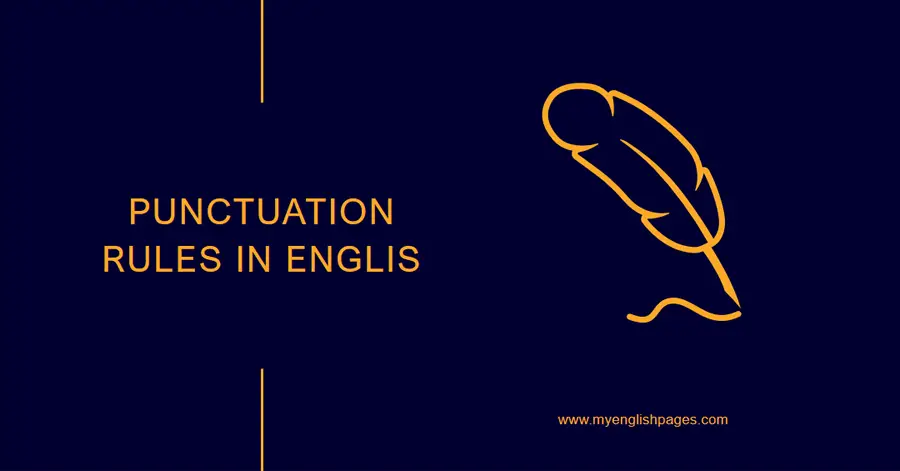Table of Contents
Introduction
Punctuation is the set of symbols and marks, such as commas, periods, and dashes, used in writing to clarify meaning, indicate pauses, and structure sentences effectively.
This article delves into the essence of punctuation and its paramount importance in writing. Clear and illustrative punctuation rules will be unveiled, guiding you through its practical application.
Let’s start with understanding what punctuation means!
What is Punctuation?
Punctuation marks are symbols that not only organize the structure of written language but also serve to convey intonation, designate pauses for proper oral expression, and prevent ambiguity.
Examples of punctuation marks include commas, periods, colons, semicolons, dashes, and quotation marks. These are used by following specific rules to enhance clarity, signify pauses, establish sentence boundaries, and convey meaning in written communication.
Let’s look at an example to understand how punctuation aids to avoid ambiguity and enhance clarity. Consider the difference between :
- “Woman, without her man, is nothing.”
- “Woman: without her, man is nothing.”
Note:
The term “punctuation” originates from the Latin word “punctuatio,” derived from “pungere,” meaning “to prick” or “to point.” This etymology underscores the historical development of standardized symbols to enhance clarity and structure in written language. Today, “punctuation” embodies the evolution of linguistic practices aimed at achieving precision and effective communication.
Why are Punctuation Rules Important?
Punctuation rules play a crucial role in written communication, acting as the silent orchestrator that brings order and clarity to the symphony of words. Its importance extends beyond mere grammatical correctness; punctuation marks serve as nuanced signals that guide readers through the rhythm and meaning of a sentence. In the absence of proper punctuation, written expression becomes akin to a musical composition devoid of notes and rests, resulting in potential confusion and misinterpretation.
Why it is important?
- Clarity: It clarifies the structure of sentences, ensuring that ideas are presented in a coherent and understandable manner.
- Meaning: It helps convey nuanced meanings by indicating pauses, emphasizing certain elements, and establishing relationships between different parts of a sentence.
- Reader Engagement: Proper punctuation enhances the reader’s experience by guiding them through the intended flow of ideas, maintaining engagement, and preventing misunderstandings.
- Grammar and Syntax: Punctuation adheres to grammatical rules and syntactical conventions, contributing to the overall correctness and professionalism of written content.
- Voice and Tone: Punctuation aids in expressing the writer’s intended voice and tone, influencing how the text is perceived by the audience.
- Ambiguity Avoidance: It minimizes ambiguity, as seen in examples like the classic “Let’s eat, Grandma” versus “Let’s eat Grandma,” where the placement of a comma drastically alters the meaning.
- Formal and Informal Conventions: Different punctuation choices can convey formality or informality, allowing writers to tailor their style to the appropriate context.
Punctuation rules
Understanding punctuation rules is essential for crafting clear and unambiguous pieces of writing. Below is a comprehensive guide to various punctuation marks along with clear explanations and illustrative examples.
Some punctuation marks, like the period, question mark, and exclamation mark, primarily function as end punctuation marks. However, various others serve distinct roles within different positions of a sentence, contributing to its structure and meaning.
1. Full Stop or Period (.)
- Used at the end of a sentence:
- She stood up and went away. She was furious.
- Used for abbreviations:
- Co. (Company)
- M.P. (Member of Parliament)
2. Question Marks (?)
- Used at the end of direct questions:
- Where do you live?
- Are you crazy?
- Used in tag questions:
- You will help me, won’t you?
- He likes soccer, doesn’t he?
3. Exclamation Marks (!)
- Used to indicate strong emotions:
- She’s so beautiful!
- What a nice girl!
- How interesting!
- Used after interjections:
- Oh! It’s awful.
- Hi! What’s up?
4. Commas (,)
- Used between items in a series or list, with the last two items connected by “and”:
- I like spaghetti, fish, pizza, and couscous.
- Used between adjectives or adverbs:
- I’d like to have a big, black, German car.
- She speaks slowly, quietly, and eloquently.
- Before or after direct speech:
- He said, “I hate being treated like that.”
- “I’m sorry,” she replied.
- Before a coordinating conjunction:
- He woke up late, so he had to drive to work.
5. Semicolons (;)
- Used instead of a full stop to separate independent sentences:
- They woke up early; then they went jogging.
- Used to separate items in a series when those items contain punctuation such as a comma:
- They visited the Eiffel Tower, Paris; Big Ben, London; and the Statue of Liberty, New York.
6. Colons (:)
- Used to introduce a list:
- He visited three cities last summer holiday: Madrid, Roma, and Athens.
- To introduce an idea or an explanation:
- He had one idea in mind: to see her as soon as possible.
- To introduce direct speech or a quotation:
- The secretary whispered in his ear: “Your wife is on the phone.”
7. Dashes (–)
- Used to introduce parenthetical information:
- I put on a blue jacket – the one my mother bought me – and blue jeans.
- To show an afterthought:
- I explained to him my point of view – at least I tried!
8. Apostrophes (‘)
- Used to indicate a missing letter or letters in a contraction:
- I’m fed up with his stories.
- Used with the letter “s” to show possession:
- My brother’s girlfriend is such a sweet girl.
9. Quotation Marks (“)
- Used to quote speech, sentences, or words:
- She said, “I love you.”
10. Ellipsis (…)
- Used to indicate the omission of words in a quote or a trailing off of thought.
- The passage was unclear in the original text…
11. Brackets ([])
- Used to enclose additional information, corrections, or clarifications within a quote.
- The author stated, “The experiment was conducted [in 2022].”
12. Parentheses (())
- Used to set off supplementary information or asides within a sentence.
- The results (although surprising) were accurate.
13. Hyphen (-)
- Used to join words, especially in compound words, or connect parts of a compound word when broken across two lines.
- She has a well-established career.
Essential Punctuation Tips
Mastering punctuation is crucial for effective communication in writing. Here are some essential tips to enhance your punctuation skills and elevate the clarity and impact of your written work:
1. End Sentences with Precision:
- Use a period (.) to indicate the end of a declarative or imperative sentence.
- Employ a question mark (?) for direct questions, and an exclamation mark (!) to convey strong emotions or exclamatory statements.
Example: The project was completed on time. Did you receive the memo? What an incredible achievement!
2. Commas for Clarity:
- Use commas (,) to separate items in a series, between adjectives, and before coordinating conjunctions in compound sentences.
- Commas also set off introductory phrases, clauses, and nonessential elements.
Example: She packed her bags, grabbed her keys, and left the house. The tall, elegant woman entered the room.
3. Navigate with Semicolons and Colons:
- Employ semicolons (;) to connect closely related independent clauses without a coordinating conjunction or to separate items in a series containing internal punctuation.
- Use colons (:) to introduce lists, explanations, or quotations.
Example: The team worked diligently; however, they missed the deadline. Remember to bring the essentials: water, snacks, and a map.
4. Embrace Dashes and Parentheses:
- Use dashes (–) to add emphasis, introduce parenthetical information, or indicate a sudden break in thought.
- Parentheses (()) enclose additional details, corrections, or asides.
Example: Her reaction—the sheer surprise—was captured on camera. The results (although unexpected) were well-received.
5. Mastery of Quotation Marks:
- Place quotation marks (“”) around direct speech, quoted sentences, or titles of short works.
- Single quotation marks (”) can be used for quotes within quotes.
Example: He said, “The meeting is at 3 PM.” The article titled ‘The Power of Words’ explores effective communication.
6. Mind Your Hyphens and Apostrophes:
- Use hyphens (-) to connect compound words, such as adjectives preceding a noun.
- Apostrophes (‘) indicate contractions or possession.
Example: It’s a well-known fact. The cat’s playful behavior is entertaining.
7. Consistency in Ellipses and Brackets:
- Utilize ellipses (…) to indicate omitted words in a quote or suggest a trailing off of thought.
- Square brackets ([]) enclose additional information or editorial comments within a quote.
Example: The passage was unclear in the original text… [emphasis added].
8. Proofread for Punctuation:
- Before finalizing your work, thoroughly proofread for punctuation errors.
- Pay attention to commonly misused marks and ensure consistency throughout your writing.
Conclusion
Punctuation rules are crucial to understand the nuance of written expression. These small marks wield immense power, transforming strings of words into coherent, impactful text. To become a skilled writer, remember that mastering the subtleties of punctuation boosts our ability to communicate effectively. Each comma, dash, and quotation mark plays a vital role in shaping meaning and intent.
Related Pages:


